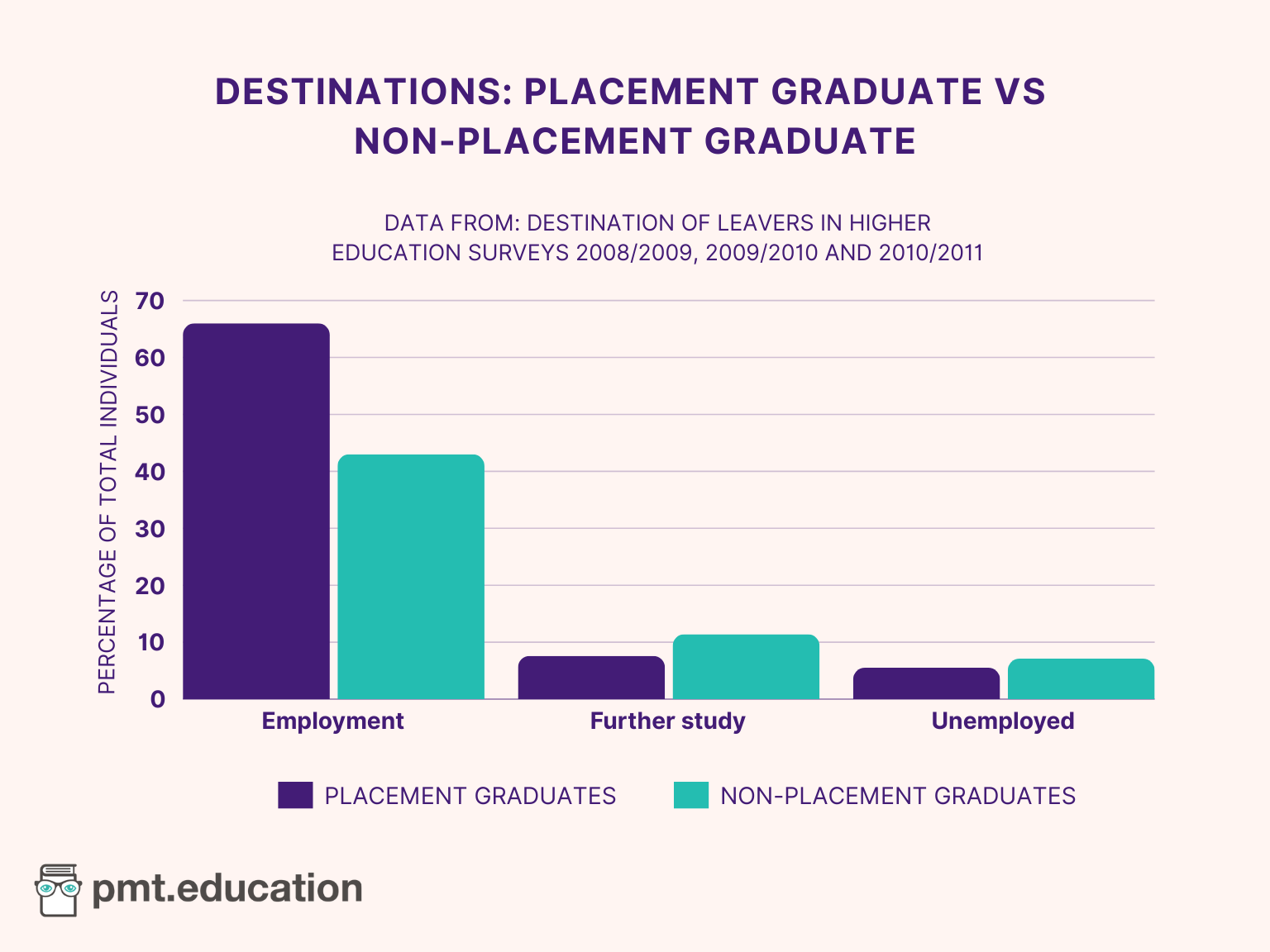Contents:
Entry Requirements: Academic performance
Cost: Placement year fees vary
Structure: Core and optional modules
Skills Developed: Practical skills, industry experience, networking
Career opportunities: Enhanced employability
What is a placement year at university?
There are many variants of STEM degrees designed to align with the experience and skills you wish to gain. One such variant is the placement year. During this year, you will take a break from your usual taught course modules to work in a subject-related industry. The placement typically takes place in the penultimate year of either a bachelor’s or integrated master’s degree, extending the programme to four or five years respectively. Unlike internships, placement years are part of your degree’s academic curriculum; you retain your student status, benefit from all university support services, and receive academic credit for your placement.
A placement year is ideal for those who have a strong interest in a particular field of work and are keen to gain more hands-on experience. This article provides a detailed explanation of placement years to help you determine if a placement year would suit you and your goals.
Before your placement year
Careful consideration is necessary to determine if a placement year is right for you, as students can have very different experiences. Ensuring the specific placement aligns with your interests and aspirations is key to enjoying your placement year.
How can you find STEM placement opportunities?
A multitude of industrial placements are available across STEM fields. To narrow down your options, you should consider which careers interest you and whether you prefer a UK or international placement. Each university department typically has specific criteria that the placement must meet, which can be found on the course webpage or by talking to your university tutors.
Your university should provide ample advice and support when applying to placements, and often have a database of established placements to share with you. With your personal and university criteria in mind, you can find relevant placements through two main routes: applying to advertised opportunities or approaching companies speculatively.

Advertised opportunities can be found through:
- University career services
- Job advertisement websites, e.g. TARGETjobs and LinkedIn (a profile on LinkedIn acts as an online CV!)
- Sites advertising STEM internships, e.g. Bright Network and Grad Cracker
- Networking events
- Career fairs
- Industry conferences
Advertised opportunities are typically with larger companies that have established placement schemes. These offer the advantage of a well-established structure and the ability to research the experiences of past placement students. You can gather this information by researching a particular company or looking on comparison websites, such as ‘Rate My Placement’.
If you have a specific company in mind that is not advertising placements, you can approach them speculatively. This means reaching out, in an appropriate manner, to express your interest in undertaking a placement with them.
How do you apply for a STEM placement year?
Whether applying to an advertised placement or approaching companies speculatively, your application should include the same important details. Follow this checklist to make sure your application includes everything that company’s are looking for:
Checklist for applying to STEM placements
- Identify placements that meet your personal and university criteria
- Research the role thoroughly before getting in touch
- Look on their company website or at the placement specification
- Use the National Careers Service or ask a Careers Advisor about the role
- Consider what you would like to gain from the placement
- Prepare your first correspondence or application including:
- CV with your achievements, experience, and skills highlighted
- Cover letter presenting yourself, your goals, your understanding of the role, and your interest in the specific company
- Be professional, concise, and polite in your communication
- Have the plan reviewed by a senior before sending
- Use an appropriate mode of contact, e.g. the company’s HR, recruitment email, or through a placement advertisement
- Do not repeatedly contact the company
- Follow up once after a couple of weeks if you have not heard anything
Industrial placement interviews
Following a successful application, most companies will invite you to interview. Interviews can be daunting, especially if you haven’t had many in the past; but rest assured, after applying for placements you will have plenty of experience. If nothing else, see this process as a great way to perfect your interview technique and set yourself up for success when it comes to applying for your first job! To help you prepare, we have created a STEM placement interview checklist:
STEM placement interview checklist
- Research the company’s mission and values
- Understand the responsibilities of your specific job role
- Prepare a list of answers to popular interview questions
- Why are you interested in this role?
- Tell us about a time when you demonstrated ‘skill X’…
- What is one of your weaknesses?
- What skills are you looking to improve?
- Prepare a list of experiences you can draw from
- Try to answer each question using a different experience
- Be ten minutes early
- Dress smartly, be positive, and try to enjoy the conversation
- Introduce yourself and thank the interviewer for their time
- Always have questions to ask the interviewer
- What do you find hardest about your role?
- What do you hope to see from your placement students?
Instead of being invited to interview, you may be invited to complete an assessment or interview task. These require you to complete activities, either online or in person, that demonstrate skills required for the role. Activities could be anything from writing tasks to aptitude tests and may be conducted as team activities with other applicants. Remember, you are being assessed not only on your technical skills but also on your interactions with others, your knowledge of the company, and your confidence in your abilities. Make sure you leave yourself ample time to complete the task, prepare as much as you can, and enjoy the opportunity to test your skills!
Top tips when applying to placements
- Apply early: Applications for most placements typically open in September of the year prior to the placement and close in January. Additionally, your university may have a deadline for approving your placement, so be sure to check their specific requirements.
- Make your CV stand out: Placements are competitive and will look for extracurricular activities demonstrating relevant skills.
- Submit a cover letter (even when optional): Showing a company you understand their mission and that your values align with their own sets you ahead of the crowd.
- Practice and prepare: Gain as much experience as possible for interviews or assessment tasks
If you plan to complete a placement year as an international student, you will need to apply for a four-year student visa. If you are already at university under a three-year visa, you will need to apply for a new, four year visa.
During your placement year
A day in the life of STEM placement year student
Placement students are typically expected to spend 8 hours a day on placement, reflecting the average working day. Unlike university, you will need to work consistently for these 8 hours, including a lunch break. Your daily schedule will vary depending on the placement but will include completing the responsibilities outlined in the placement description (which your provider should show you) and often some time to study supporting materials and document your workplace experiences. There are many students who have created vlogs explaining what a day in the life of a STEM placement student looks like.

You will be assigned a placement supervisor from university who will keep in contact with you throughout the placement year. They may visit you at your placement, request reports on your experiences, and mainly act as a support resource for any questions or concerns you may have.
How is a placement year assessed?
The placement year is usually assessed through a reflective report, which is an extended written piece evaluating your experience. The record you keep throughout the placement year will be valuable for this report. The placement year is graded a pass or fail and does not contribute to your degree classification. However, the pass is required to receive credit for the year in your degree title.
Top tips for getting the most out of your placement year
- Set clear goals: Identify gaps in your skill set and set goals to improve in these areas. Share these goals with your manager so they can provide support and guidance.
- Become a valuable team member: Aim to be an indispensable placement student by excelling in your tasks and showcasing your value, increasing your chances of securing future opportunities with the company.
- Network: Build relationships with colleagues and industry professionals.
- Document your experience: Track your progress and achievements.
- Balance work and study: Ensure you meet any academic requirements alongside your placement duties.
After your placement year
After your placement year, you will return to the final year of your university degree, studying with those who were in the cohort below you. So, what advantage does completing a placement year offer as you move forward?
Completing a placement year could improve your chance of receiving a higher degree classification. Placement students have demonstrated a greater improvement in academic performance between their second and final year of study compared to those who did not complete a placement.
Having gained industry experience and networking opportunities, you will likely be ahead of other applicants when applying for jobs after university. Graduates with a placement year are more likely to find full-time employment compared to those without one.

Additionally, those who completed a placement year are more likely to land graduate-level roles with higher starting salaries. Beyond increased employability, placement students are also more likely to feel confident in the workplace and the application process. This can be attributed to their familiarity with working life, additional interview experience, and clearer career goals. Additionally, the reflective project from your placement can enhance your CV and provide valuable examples for interviews, so be sure to keep your work!
Interestingly, a higher proportion of non-placement graduates enter further education and academia compared to those who completed a placement year. This may reflect placement graduates feeling more satisfied with their learning experiences or indicate that non-placement graduates have a stronger desire to pursue further study rather than working in industry.
Is a placement year worth it?
Some students have reported that their placement year was completely worth it. While placement years clearly enhance employability, their value depends largely on the individual student and their goals. By investigating what previous students have identified as the advantages and disadvantages of placement years, you can begin to see what aspects might appeal to you or deter you. If you believe the benefits of a placement year outweigh any potential disadvantages, then a placement year could be worthwhile.
If you’re not sure whether a placement year is for you, consider reading articles on the benefits of placement years, and talk to a tutor or careers advisor before making your final decision. You may also wish to explore our article on work experience and internships opportunities. While the article is aimed at secondary school students, the experiences are relevant to university students too!
FAQs
What is sandwich study?
A placement year can also be known as a sandwich year, year in industry, or industrial placement. All these terms refer to an integrated year within your bachelor’s degree, in which you work in an industry related to your area of study.
How long is a placement year?
The duration of placements varies between companies. Your university will set a minimum requirement for placement length, which can typically be found in your department’s placement criteria. Usually a placement must last between 9 and 12 months.
Is it hard to get a placement year?
Securing a placement year can be competitive due to limited positions and high demand. Fortunately, following the advice in this article should position you as a strong candidate for competitive placement opportunities!
Do you get paid for a placement year?
There are unpaid and paid industrial placement opportunities. You will not receive a student loan during your placement year, but can obtain a maintenance loan of around £3,000. It is therefore essential to consider how you will finance a year’s living expenses and a paid placement is often the answer. Think about:
- How much your placement pays
- How much maintenance loan you are eligible for
- Funding options available to you (more information on these options can be found in our article on scholarships, grants and bursaries)
- Cost of rent
- Cost of travel to placement
- Other living expenses
The return on investment of a placement year is an important factor to consider. With benefits such as enhanced employability, higher starting salaries, and clarification of career aspirations, a placement year can offer significant advantages. Assess which funding options are available to you and consider all the costs associated with your placement to determine its worth.
What happens if you do not pass a placement year?
If you do not fulfil the minimum duration or fail to pass the placement year, you will return to your original programme of study with no impact on your degree classification. However, the placement year will not appear in your degree title.

Comments